Moniek Bloks's Blog, page 25
January 14, 2025
Taking a look at Princess Michael of Kent
As she celebrates her 80th birthday, we take a look at the life of Princess Michael of Kent.
Baroness Marie-Christine Anna Agnes Hedwig Ida von Reibnitz was born on 15 January 1945 as the youngest daughter of Günther-Hubertus Freiherr (Baron) von Reibnitz and his second wife, Countess Maria Anna Szapáry von Muraszombath, Széchysziget et Szapár. She has an older full brother, Friedrich and an older half-sister, Margarita (died 2012). Marie-Christine was born in Tachau, now known as Tachov in present-day Czech Republic. Her mother had just been released from a Nazi prison camp after she was arrested for taking part in an anti-Nazi Party demonstration, and her father was being held as a prisoner of war.
Her father was a member of the Nazi Party, and he had served in the Waffen-SS. As the Russians advanced, the family was forced to abandon their residence, and they moved to Bavaria in Germany, which was then part of the American-occupied zone. Her father managed to escape and was able to rejoin his family. However, between 1947 and 1948, he was tried by a Bavarian de-Nazification court, and he was classified as a “lesser offender”, the third of five classifications. He appealed and was later classified as a mere “follower.”
Her parents separated when it became clear that her father’s first marriage had not been annulled. As a devout Catholic, her mother could not continue living with him. As she had married him in good faith, their children were still considered legitimate. Her father left to travel around Africa, where he would meet his third and fourth wives. Her mother decided to start a new life in Australia with her two young children. They settled in Sydney, where her mother eventually remarried a Polish nobleman.
While in Australia, Marie-Christine attended a prep school called Baratburn, where nuns from the Sacred Heart Order taught. At the age of 8, she moved to the sister convent at Elizabeth Bay in Kincoppal, where she could be a weekly boarder. When that school closed, she was transferred to the Rose Bay Convent. When she finished school at 16, her mother sent her to Mozambique to live with her father for two years. After this, she travelled to Vienna, where she stayed with an uncle and took courses in art history. She then decided on interior design, for which she moved to the United Kingdom, and she was taken in by one of her mother’s many friends. She then set up her own business, Szapáry Designs., which was quite successful.
Marie-Christine met her future first husband on a boar hunt on the German estate of the family. His name was Tom Troubridge, and he was a successful banker. Their engagement was formally announced on 25 May 1971. As a Catholic, Marie-Christine required a dispensation for a Catholic-Anglican service. Their wedding took place on 15 September 1971, with Father Jean Charles-Roux standing as the essential Catholic witness. She was given away by her uncle, Count Ladislaus. Her brother, Friedrich, had married the day before in Australia, and her father was also not present as he had recently had a heart attack.
The newlyweds had a lively social circle, and sometime in 1972, Marie-Christine met Prince Michael of Kent, a first cousin of Queen Elizabeth II, at the home of Prince William of Gloucester, a school friend of her husband’s. She later recalled, “I thought he was the funniest man I had ever met. We just kept laughing and talking together. But I didn’t think he had really ‘noticed’ me at all. He was with such a pretty girl.”1 Their friendship began to develop over the years, and her marriage became strained. Not much later, she moved out of the family home. In 1976, it was Lord Mountbatten who told Marie-Christine she should marry Michael.
In the summer of 1977, Thomas and Marie-Christine’s marriage was dissolved after they had lived apart for three years. An annulment proved a bit harder to obtain, and it was only granted in May 1978. Prince Michael needed the consent of the monarch to marry, and she gave it, which may have been surprising given the circumstances. Had The Queen taken a softer stance? The Queen’s permission could not fix the fact that Prince Michael would lose his place in the line of succession by marrying a Roman Catholic. He was 15th in the line of succession at the time. The Succession to the Crown Act 2013 returned Prince Michael to the line of succession in 2015.
Embed from Getty ImagesOfficially labelled a “divorcee” according to the Anglican church, they were forced to plan a Catholic wedding, and Prince Michael needed dispensation for this “mixed marriage.” However, this dispensation was not granted, and they ended up having a civil wedding in Vienna. Upon marriage, she became Her Royal Highness Princess Michael of Kent, taking on the feminine form of her husband’s title. It wasn’t until 1983 that they received a Roman Catholic blessing for the marriage.
Embed from Getty ImagesEmbed from Getty ImagesOn 6 April 1979, Marie-Christine gave birth to her first – a boy named Frederick – styled as Lord Frederick Windsor. On 23 April 1981, a daughter was born. She was styled as Lady Gabriella Windsor until her wedding to Thomas Kingston in 2019. The family lived at Kensington Palace, and Prince Michael had inherited the contents of his mother’s apartment, leaving them with plenty of furniture to decorate. They were not provided for by the Civil List, and for a long time, they paid only a nominal amount for their apartment. Marie-Christine kept her interior design business going, although she was now only acting as a consultant. She also began writing books.
Embed from Getty ImagesIt wasn’t until 1985 that Marie-Christine learned the full extent of her father’s Nazi past. She had been raised almost entirely without her father, so perhaps this is not as strange as one might think. She later spoke of her “deep shame.” She added, “Here I am, 40 years old, and I discover something that is really quite unpleasant. I shall just simply have to learn to live with it.”2
Embed from Getty ImagesMarie-Christina is active for several animal conservation organisations and undertakes charitable engagements, although these have decreased over the years. She has not remained without controversy, and she has been accused of being racist on several occasions, such as when she wore a blackamoor brooch to a lunch where the future Duchess of Sussex was also present.3
Embed from Getty ImagesThe post Taking a look at Princess Michael of Kent appeared first on History of Royal Women.
January 12, 2025
Queen Ada I of Caria- The adopted mother of Alexander the Great
Queen Ada I of Caria was the last ruler of the Hecatomnid Dynasty.[1] She co-ruled with her brother, King Idrieus. After his death, she became queen regnant. Queen Ada I of Caria lost the throne to her younger brother, King Pixodarus. However, she became the adopted mother of Alexander the Great, who restored her throne.
In circa 380 B.C.E., Queen Ada I of Caria was born. She was the daughter of Prince Hecatomnus of Caria, the founder of the Hecatomnid Dynasty that ruled in the fourth century B.C.E.[2] She had three brothers named Prince Mausolus, Prince Idrieus, and Prince Pixodarus.[3] She also had an older sister named Princess Artemisia (who would later become Queen Artemisia II of Caria).[4]
Princess Ada married her brother, Prince Idrieus.[5] After Queen Artemisia II’s death in 351 B.C.E., Prince Idrieus became King of Caria.[6] Ada became Queen and co-ruler of Caria.[7] During their reign, King Idrieus and Queen Ada I continued to strengthen the Carian empire.[8] In 344 B.C.E., King Idrieus died. Queen Ada I succeeded him to the throne of Caria and became queen regnant.[9]
Queen Ada I’s reign lasted three years. Her younger brother, Prince Pixodarus, was upset that he did not inherit the throne of Caria from King Idrieus.[10] In 340 B.C.E., Pixodarus ousted Queen Ada I from the throne.[11] He became King of Caria. However, Queen Ada I managed to gain support from people who lived in the countryside of Caria.[12] With their support, she managed to keep Alinda (which was the strongest fortress in Caria).[13]
In 334 B.C.E., King Pixodarus died. The throne of Caria was passed to his son-in-law, Orontobates.[14] Orontobates had married King Pixodarus’s daughter, Ada II.[15] King Orontobates and Queen Ada II became joint rulers of the Carian empire.[16] However, their reign was weak.[17] They could not send troops to the Persian army to fight against Alexander the Great’s army.[18]
In 334 B.C.E., Alexander the Great entered Caria. Queen Ada I surrendered the Alinda fortress to him.[19] She even adopted Alexander the Great as her son.[20]Alexander the Great restored her to the throne of Caria.[21] However, he still had to conquer the capital of Halicarnassus.[22] He managed to take the living quarters at Halicarnassus.[23] He left a garrison to continue the war.[24] A year later, his army managed to defeat King Orontobates and Queen Ada II.[25] The fate of King Orontobates and Queen Ada II is unknown.[26] Queen Ada I remained queen regnant of Caria until her death in 326 B.C.E.[27] In 1989, Turkish archaeologists believed that they had found her tomb.[28] They sent her bones to the Archeological Museum of Bodrum.[29]
Queen Ada I reigned Caria twice. She proved to be a brilliant military strategist by maintaining the Alinda fortress.[30] She also made a clever ploy in adopting Alexander the Great.[31] By adopting him, Queen Ada I of Caria was restored to her position as queen regnant, where she ruled uncontested until her death.[32] Even though Queen Ada I failed as ruler during her first reign, she managed to prove herself as a capable and successful queen.[33]
Sources:
Fabre-Serris, J. & Keith, A. (2015). Women and War in Antiquity. Baltimore: John Hopkins Press.
Lendering, J. (27 April, 2019). “Ada”. Livius.org. Retrieved on June 1, 2024 from https://www.livius.org/articles/perso....
[1] Fabre-Serris and Keith, 2015
[2] Lendering, 27 April 2019
[3] Lendering, 27 April 2019
[4] Lendering, 27 April 2019
[5] Fabre-Serris and Keith, 2015
[6] Fabre-Serris and Keith, 2015
[7] Fabre-Serris and Keith, 2015
[8] Lendering, 27 April 2019
[9] Fabre-Serris and Keith, 2015
[10] Lendering, 27 April 2019
[11] Fabre-Serris and Keith, 2015
[12] Lendering, 27 April 2019
[13] Lendering, 27 April 2019; Fabre-Serris and Keith, 2015
[14] Fabre-Serris and Keith, 2015
[15] Fabre-Serris and Keith, 2015
[16] Fabre-Serris and Keith, 2015
[17] Lendering, 27 April 2019
[18] Lendering, 27 April 2019
[19] Lendering, 27 April 2019
[20] Fabre-Serris and Keith, 2015
[21] Fabre-Serris and Keith, 2015
[22] Lendering, 27 April 2019
[23] Lendering, 27 April 2019
[24] Lendering, 27 April 2019
[25] Lendering, 27 April 2019
[26] Lendering, 27 April 2019
[27] Lendering, 27 April 2019
[28] Lendering, 27 April 2019
[29] Lendering, 27 April 2019
[30] Fabre-Serris and Keith, 2015
[31] Fabre-Serris and Keith, 2015
[32] Lendering, 27 April 2019
[33] Fabre-Serris and Keith, 2015
The post Queen Ada I of Caria- The adopted mother of Alexander the Great appeared first on History of Royal Women.
January 11, 2025
Book News Week 3
Book News week 43 – 13 January – 19 January 2025

Secrets of a Suitcase: The Countess, the Nazis, and Middle Europe’s Lost Nobility
Hardcover – 15 January 2025 (US)
The post Book News Week 3 appeared first on History of Royal Women.
January 10, 2025
Five royal uncle-niece marriages (Part three)
Royal uncle-niece marriages happened several times over the years. These marriages often happened for strategic reasons, such as land or power, but also because of rank and status. There simply weren’t enough others of high enough rank for marriage. The offspring of such marriages often suffered from genetic abnormalities, such as the famous Habsburg jaw. Quite often, these children did not survive to adulthood.
Here are five more of those marriages:
11. Margravine Elisabeth Louise of Brandenburg-Schwedt & Prince Augustus Ferdinand of Prussia
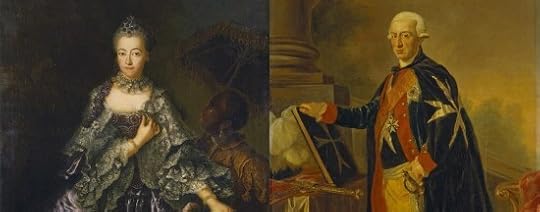 (public domain)
(public domain)Elisabeth Louise of Brandenburg-Schwedt was born on 22 April 1738, the daughter of Frederick William, Margrave of Brandenburg-Schwedt, and Princess Sophia Dorothea of Prussia. She was the second of five children, although only two other siblings survived to adulthood. On 27 September 1755, she married her maternal uncle, Prince Augustus Ferdinand of Prussia, who was eight years older than her. They went on to have seven children together, of which four died young. She was widowed in 1813, and she died on 22 February 1820.
12. Joanna of Castile & King Alfonso V of Portugal
 (public domain)
(public domain)Joanna of Castile, perhaps better known in history as Joanna La Beltraneja, was born on 28 February 1462 as the daughter of King Henry IV of Castile and Joan of Portugal. Her paternity was questioned, and her nickname referred to the supposed father, Beltrán de la Cueva, 1st Duke of Alburquerque. As her father’s only child, she was the heiress to the Castilian throne. Her aunt, the future Queen Isabella I of Castile, became the face of a rebellion, and after King Henry’s death, she claimed the throne. In an attempt to win it back, the then 13-year-old Joanna married her 43-year-old maternal uncle, King Afonso V of Portugal, on 29 May 1475. King Afonso invaded Castile to support Joanna’s claim shortly after their betrothal ceremony on 1 May. Afonso did not consummate the marriage with his 13-year-old niece as he went to war. At this point, there was no papal dispensation, and this only came the following year in February. Ultimately, Joanna was forced to enter a convent, and the papal dispensation was retracted in December 1478.
13. Maria Anna of Bavaria & Charles II, Archduke of Austria
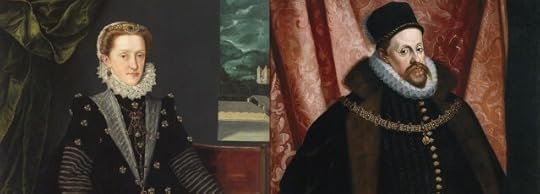 (public domain)
(public domain)Maria Anna of Bavaria was born on 21 March 1551 as the daughter of Albert V, Duke of Bavaria and Anna of Austria. On 26 August 1571, the 20-year-old Maria Anna married her 31-year-old maternal uncle, Charles II, Archduke of Austria, the third son of Ferdinand I, Holy Roman Emperor and of Anne of Bohemia and Hungary. They went on to have fifteen children together, of which four did not survive to adulthood. One of her daughters, Maria Christina, was described as having “serious physical and mental problems”, but these claims are not supported with any evidence.1 Maria Anna was widowed in 1590 and she died on 29 April 1608. Her son went on to marry her name-sake niece, Maria Anna of Bavaria.
14. Sabina Catharina of East Frisia & John III of Rietberg
Sabina Catharina of East Frisia was born on 11 August 1582 as the daughter of Count Enno III of East Frisia and his first wife, Countess Walburgis of Rietberg. Her mother was Countess of Rietberg in her own right, and Sabina was given this inheritance when her father wanted to remarry following her mother’s death. On 3 March 1601, Sabina Catharina married her uncle, John, and she converted to the Catholic faith. The papal dispensation for this marriage had been granted in 1600. They went on to have eleven children together, of which five died young. She died giving birth to their eleventh child on 31 May 1618.
15. Johanna Beatrix von Dietrichstein-Nikolsburg & Karl Eusebius, Prince of Liechtenstein
Johanna Beatrix von Dietrichstein-Nikolsburg was born in 1625 as the daughter of Maximilian, Prince of Dietrichstein and Princess Anna Maria of Liechtenstein. Her mother was a daughter of Karl I, the first Prince of Liechtenstein. Johanna Beatrix married her mother’s younger brother, Karl Eusebius, Prince of Liechtenstein, in 1644. He was fourteen years older than her. They went on to have 11 children together, of which four survived to adulthood. She died on 26 March 1676.
Part four coming soon.
The post Five royal uncle-niece marriages (Part three) appeared first on History of Royal Women.
January 9, 2025
The Dutch Aquamarine Parure Tiara
The Dutch Aquamarine Parure Tiara was given to the future Queen Juliana in 1927 as a birthday present from her parents, Queen Wilhelmina and Prince Henry.
The tiara consists of pear-shaped briolette and square-cut Brazilian aquamarines and diamonds. It was made by van Kempen, Begeer and Vos Jewellers.
Embed from Getty ImagesThe tiara has been worn by most of the Dutch Queens and Princesses, including those who married into the family. It became part of the Jewel Foundation in 1960, and it cannot be sold.1
Embed from Getty ImagesPieces were added to the parure over time, including two necklaces, a pendant, a pair of earrings and a brooch.
The post The Dutch Aquamarine Parure Tiara appeared first on History of Royal Women.
January 7, 2025
Princess Huai Ying – The Princess who helped her hostage husband escape captivity from her father
Princess Huai Ying was the wife of Duke Huai of Jin. During the year of 638 B.C.E., Princess Huai Ying was forced to choose between her father and her husband.[1] In the end, Princess Huai Ying handled the tough predicament wisely.[2] Her decision earned her praise from ancient chroniclers for being unbiased.[3] Princess Huai Ying was also known for being a capable diplomat.[4] She managed to maintain peace between her natal State of Qin and Jin (which was the state where she was briefly a duchess).[5]
In circa 650 B.C.E., Princess Huai Ying was born.[6] She lived during the Spring and Autumn period, which lasted from 771 to 453 B.C.E.[7] During this period, Chinese states were declaring their own independence from the ruling Zhou Dynasty to form their own dynasties.[8] Her name is unknown.[9] She was a Princess of the State of Qin.[10] Ying was the surname of the royal family of the State of Qin.[11] Huai was the posthumous name of her husband.[12] Therefore, her name means “lady of the Ying clan, [consort of Duke] Huai.” [13] Her father was Duke Mu of Qin.[14]
The State of Qin was rivals with the State of Jin (which is in present-day Shanxi and Hebei Provinces). In 643 B.C.E., the State of Qin had taken Crown Prince Yu of Jin (the future Duke Huai of Jin) as a hostage. Duke Mu of Qin arranged for Princess Huai Ying to marry Crown Prince Yu of Jin to ensure that he would not escape the State of Qin.
In 638 B.C.E., Crown Prince Yu of Jin prepared for his escape back to the State of Jin.[15] He asked Princess Huai Ying if she could flee with him.[16] Princess Huai Ying then had to make a difficult choice between her father and her husband.[17] She decided to let him escape back to the State of Jin and not tell her father about Crown Prince Yu’s plans.[18] However, she would not flee with her husband to the State of Jin.[19]
In 637 B.C.E., Crown Prince Yu ascended to the State of Jin’s throne as Duke Huai.[20] This made Princess Huai Ying the Duchess of Jin.[21] However, she was still left behind in the State of Qin.[22] Duke Huai of Jin’s reign was brief.[23] In that same year, he was murdered by his uncle, Prince Chong’er of Jin.[24]
In 636 B.C.E., Prince Chong’er ascended to the State of Jin’s throne as Duke Wen.[25] During that same year, Duke Wen of Jin sent for Princess Huai Ying to live in the State of Jin.[26] This was because Princess Huai Ying would advise him on diplomatic affairs between the States of Qin and Jin.[27] Thus, Princess Huai Ying helped establish a strong relationship between the States of Qin and Jin.[28] Princess Huai Ying died in 620 B.C.E.[29]
Princess Huai Ying married Crown Prince Yu of Jin to prevent him from escaping to the State of Jin.[30] She was forced into a difficult decision to choose between her father and husband.[31] In the end, she chose to be neutral.[32] She would remain loyal to her father by not escaping with her husband to the State of Jin.[33] She was also loyal to her husband by not divulging to her father his escape plans.[34] She was also a skilled diplomat and made peaceful negotiations between the States of Qin and Jin.[35] Ancient chroniclers have portrayed her “for being impartial” [36] and for “controlling her heart very evenly.” [37] In Biographies of Eminent Women, her biography is categorised under “Biographies of the Chaste and Righteous.” [38]
Sources:
Cook, C. A., Hendrischke, B. (2015). “Ying, Wife of Duke Huai of Jin”. Biographical Dictionary of Chinese Women: Antiquity Through Sui, 1600 B.C.E. – 618 C.E. (L. X. H. Lee, Ed.; A. D. Stefanowska, Ed.; S. Wiles, Ed.). NY: Routledge. pp. 88-89.
Eno, R. (2010). 1.7. Spring and Autumn China (771-453). Indiana University, PDF.
Liu, X., Kinney, A. B. (2014). Exemplary Women of Early China: The Lienü Zhuan of Liu Xiang. United Kingdom: Columbia University Press.
O’Hara, A. R. (1978). “The Biographies of Chinese Women.” The Position of Woman in Early China: According to the Hieh Nü Chuan. Taiwan: Mei Ya Publications. pp. 127-153.
[1] Cook & Hendrischke, 2015
[2] Cook & Hendrischke, 2015
[3] Cook & Hendrischke, 2015
[4] Cook & Hendrischke, 2015
[5] Cook & Hendrischke, 2015
[6] Cook & Hendrischke, 2015
[7] Eno, 2010
[8] Eno, 2010
[9] Liu & Kinney, 2014
[10] Cook & Hendrischke, 2015
[11] Liu & Kinney, 2014
[12] Liu & Kinney, 2014
[13] Liu & Kinney, 2014, p. 242
[14] Cook & Hendrischke, 2015
[15] Cook & Hendrischke, 2015
[16] Cook & Hendrischke, 2015
[17] Cook & Hendrischke, 2015
[18] Cook & Hendrischke, 2015
[19] Cook & Hendrischke, 2015
[20] Liu & Kinney, 2014
[21] Liu & Kinney, 2014
[22] Liu & Kinney, 2014
[23] Liu & Kinney, 2014
[24] Liu & Kinney, 2014
[25] Liu & Kinney, 2014
[26] Cook & Hendrischke, 2015
[27] Cook & Hendrischke, 2015
[28] Cook & Hendrischke, 2015
[29] Cook & Hendrischke, 2015
[30] Cook & Hendrischke, 2015
[31] Cook & Hendrischke, 2015
[32] Cook & Hendrischke, 2015
[33] Cook & Hendrischke, 2015
[34] Cook & Hendrischke, 2015
[35] Cook & Hendrischke, 2015
[36] Cook & Hendrischke, 2015, p. 89
[37] Cook & Hendrischke, 2015, p. 89; O’Hara, 1978, p. 131
[38] Cook & Hendrischke, 2015, p. 89
The post Princess Huai Ying – The Princess who helped her hostage husband escape captivity from her father appeared first on History of Royal Women.
January 6, 2025
The Year of Queen Sālote Tupou III – The life of Prince Sione Ngū Manumataongo
On 7 January 1922, Queen Sālote Tupou III gave birth to her third son, Prince Sione Ngū Manumataongo. Prince Siaosi Tāufaʻāhau Tupoulahi, the future King Tupou IV, had been born in 1918, and Prince Uiliami Tuku‘aho was born in 1919.
Shortly after his birth, Queen Sālote went to New Zealand for several months for a much-needed break. She left Tonga at the end of October with her three sons, three female companions, and attendants to look after her and the children. At 22, Queen Sālote was still quite young, and she had been Queen for six years. She had also been married to Prince Viliami Tungī Mailefihi for six years. The ten-year-old Princess Fusipala, the Queen’s half-sister, joined them for part of the holiday.
Following their return from New Zealand, the three princes were sent to a woman named Rachel for early instruction and discipline. All three had to be trained as future leaders, but especially the eldest as the future King. They had a strict childhood, and they were disciplined with beatings. Reportedly, the eldest brother never cried, unlike his younger siblings.
After some time with Rachel, the boys were sent to the Wesleyan “European School.” Dorothy Ferguson, who taught the youngest two, later wrote of their spoilt behaviour, “I had to reprimand Prince John [Sione Ngū] for punching another boy in the eye. Smacked his hand (far too softly) and stood him in the corner. He did not worry about.”1 They later also attended Tupou College.
The second brother, Prince Uiliami Tuku‘aho, had been sickly for much of his life. At the end of 1935, he was seriously ill again, and his mother cared for him personally. By April 1536, it was clear that he was dying. It seemed that everyone knew, but it was never spoken out loud. Queen Sālote asked Dr Wood to see her son, and he diagnosed dropsy. On 23 April, 30 pints of fluids were drained. The area around them went quiet – there was no music, and the annual Anzac Day was limited to a brief prayer. The young Prince died on 28 April around 11.30 P.M. After months of caring for her son, Queen Sālote completely broke down. She and her husband went to visit Sydney for rest and a medical check-up.
While the Crown Prince enrolled as a law student at the University of Sydney, Prince Sione Ngū spent three years with a private tutor in Auckland to prepare for his attendance at Newington College in Sydney.
In 1941, Prince Sione Ngū’s father became unwell. On 19 July, he had dinner at the British Residency. The following day, he went to church and had lunch before laying down for a nap. He suffered a heart attack in his sleep. Instead of an official lying-in-state, Queen Sālote had his body brought to her own room in the palace. His body rested there until 22 July and was then brought down so that the final respects could be paid. During this time, both the Crown Prince and Prince Sione Ngū were in Sydney, and they had asked their mother to delay the final ceremonies of the funeral until they were back in Tonga, but they were unable to return home for Christmas. Queen Sālote then decided to go ahead, meaning that the Princes missed the ceremonies.
Prince Sione Ngū’ returned to Tonga in January 1944 after one year at the Gatton Agricultural College in Queensland. Queen Sālote wanted him to spend some time learning Tongan traditions and customs. In the middle of 1944, she appointed him to the position of visiting copra inspector. He was considered to be obedient and good-natured but more outgoing than his elder brother. Both of them enjoyed a Westernised lifestyle.
In September 1944, Prince Sione Ngū was appointed the title of Tuʻipelehake, and he was no longer known as Sione Ngū. He became informally known as Fatafehi and formally as Tuʻipelehake. This was the second highest ranking chiefly title in Tonga, and the following year, the people of the Tuʻipelehake estates brought presentations for their new chief.
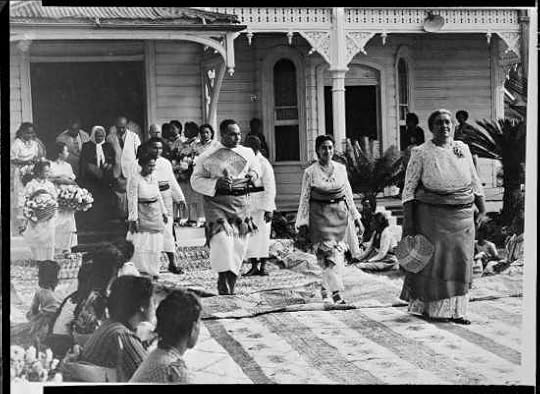 Creator unknown: Photograph taken at the double wedding of the sons of Queen Salote of Tonga, Nuku’alofa, Tonga. Ref: 1/2-005252-F. Alexander Turnbull Library, Wellington, New Zealand. /records/23095624
Creator unknown: Photograph taken at the double wedding of the sons of Queen Salote of Tonga, Nuku’alofa, Tonga. Ref: 1/2-005252-F. Alexander Turnbull Library, Wellington, New Zealand. /records/23095624Just three years later, both Princes simultaneously announced their betrothals. For Tuʻipelehake, his future wife was Melenaite Tupou Moheofo, who was a great-granddaughter of the last Tu’i Tonga (from a line of Tongan Kings). She was educated at Ravenswood Methodist School for Girls in Sydney. A double wedding was organised so that the people wouldn’t be burdened with the cost of two separate weddings.
Embed from Getty ImagesThe wedding took place over three days, from 10 to 12 June 1947. There was a European ceremony on 10 June and a traditional Tongan ceremony on 12 June. Both couples were married at the Royal Chapel. Queen Sālote was delighted to have daughters at last, and she was especially fond of Melenaite, whom she often took with her, even on extended visits. Her first grandchildren were born the following year as the Crown Prince’s wife, Halaevalu Mataʻaho, gave birth to a son on 4 May 1948, followed by a daughter born to Melenaite on 12 May 1948. Melenaite and Tuʻipelehake went on to have five more children over the years.
Embed from Getty ImagesBetween 1949 and 1952, Tu’ipelehake was the governor of Vava’u, which is the northernmost of the three groups of islands that make up the country. He later also served briefly as Governor of Haʻapai before being appointed as Minister of Health and Lands while his elder brother continued as Minister for Education and Agriculture and Prime Minister.
Embed from Getty ImagesOn 16 December 1965, Queen Sālote died in a hospital in Auckland, New Zealand. Tu’ipelehake and his wife were present when she died. The Crown Prince and his wife were en route but arrived too late. The new King was proclaimed in Tonga in his absence, and a six-month mourning period was set. Two days later, the new King and Queen travelled ahead to Tonga while Tu’ipelehake and Melenaite would accompany the body of the late Queen. The funeral took place on 23 December in Tonga. Tu’ipelehake’s title was only second to the new King, and his rank was fully recognised during the following ceremonies. Like the new King, he would be addressed in the royal language that had been reserved for the late Queen, and he would be addressed as “Eiki Hā’ele’ (Royal Chief) and Tu’i Fale Ua (Ruler of the Second House). His brother appointed him as the new Prime Minister, Minister for Foreign Affairs, Education, Agriculture and Works. He remained on as Prime Minister until his health declined in 1991.2
Embed from Getty ImagesIn 1966, he received an honorary CBE in Queen Elizabeth II’s birthday list, to which he replied, “The award is very high indeed, yet it was a great surprise to me, as I cannot think of any accomplishment that I have done.”3
Prince Fatafehi Tuʻipelehake died on 10 April 1999 after a long illness.
The post The Year of Queen Sālote Tupou III – The life of Prince Sione Ngū Manumataongo appeared first on History of Royal Women.
January 5, 2025
Book Review: Princess Ruth Ke’elikōlani by Kristin Zambucka
Princess Ruth Ke’elikōlani was born in 1826 as the daughter of Kalani Pauahi and Mataio Kekūanaōʻa, although his paternity has been questioned. She was hānai adopted by Queen Kaʻahumanu. Kalani Pauahi died giving birth to her daughter. The doubts about Princess Ruth Ke’elikōlani’s paternity gave concerns for the line of successions. Nevertheless, she was one of the last chiefesses of old Hawai’i and a well-respected member of the community.
Princess Ruth Ke’elikōlani by Kristin Zambucka is a small volume about one of the more unknown members of the Hawaiian royal family. The book is chockful of photos, but they are very strangely coloured in a purple-reddish tint. The design of the book is a little weird, with over-the-top chapter titles and font. It is nice to learn more about Princess Ruth Ke’elikōlani, but I could have done without the numerous mentions of her “massive” weight.
Overall, Princess Ruth Ke’elikōlani by Kristin Zambucka is an informative book, but it has its flaws. It is available now in the US and the UK.
The post Book Review: Princess Ruth Ke’elikōlani by Kristin Zambucka appeared first on History of Royal Women.
January 4, 2025
Book News Week 2
Book News week 2 – 6 January – 12 January 2025
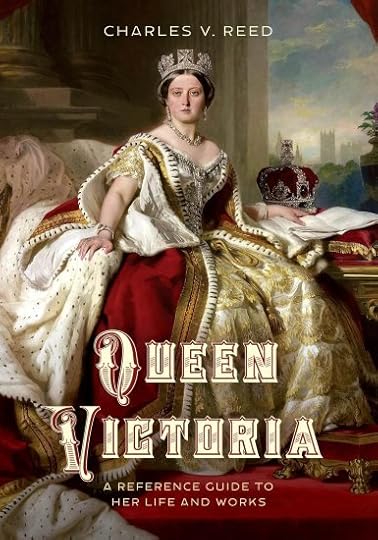
Queen Victoria: A Reference Guide to Her Life and Works (Significant Figures in World History)
Hardcover – 7 January 2025 (US)

Bathild of Francia: Anglo-Saxon Slave, Merovingian Queen, and Abolitionist Saint (Women in Antiquity)
Paperback – 6 January 2025 (UK)
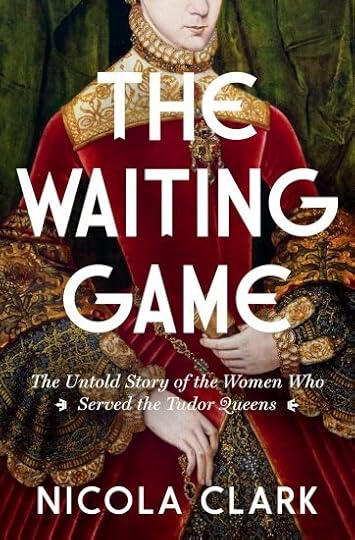
The Waiting Game: The Untold Story of the Women Who Served the Tudor Queens: A History
Hardcover – 7 January 2025 (US)
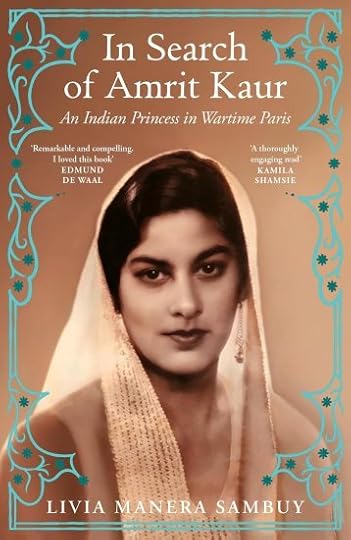
In Search of Amrit Kaur: An Indian Princess in Wartime Paris
Paperback – 9 January 2025 (UK)
The post Book News Week 2 appeared first on History of Royal Women.
January 2, 2025
The Savoy-Aosta Tiara
The Savoy-Aosta Tiara found its way into the Belgian royal family through Princess Astrid’s husband.
The tiara is likely set in platinum and features floral and scroll motifs.
The tiara’s provenance dates back to Princess Anne of Orléans. She was the daughter of Prince Jean, Duke of Guise, and Princess Isabelle of Orléans. In 1927, she married Prince Amedeo of Savoy, the future Duke of Aosta.
Embed from Getty ImagesThe tiara was eventually inherited by Anne’s daughter, Margherita, who was married to Archduke Robert of Austria-Este. It was their son, Lorenz, who married Princess Astrid of Belgium in 1984. It is likely that he inherited the tiara, enabling Princess Astrid to wear the tiara when she likes.
The post The Savoy-Aosta Tiara appeared first on History of Royal Women.



